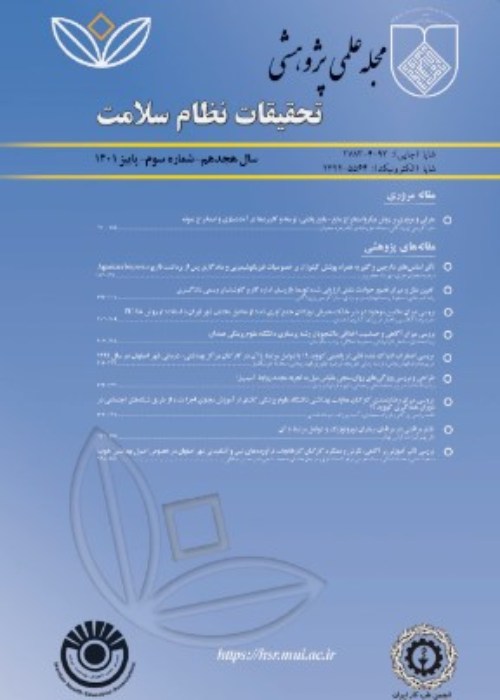Survey of predictors osteoporosis preventive behaviors among women in Fasa: Integrated of the Health Belief Model and Social Cognitive Theory
Author(s):
Abstract:
Background
Investigating factors affecting the adoption of preventive behaviors in women with osteoporosis using patterns that identify the effective factors which influence and reinforce on behavior is necessary. This study aims to determination the preventive treatment of osteoporosis in women in Fasa using the health belief model and social cognitive theory in 2014.Methods
In this cross-sectional study, 401 women 30 to 50 years covered by health centers in Fasa were randomly chosen. Scale factors for health belief model (perceived susceptibility, severity, threat, benefits, barriers and self-efficacy, practice guidelines) and the self-regulation, social support structure of social cognitive theory, and function feeding and walking were determined to prevent osteoporosis in women. Finally, using the SPSS version 16software through tests, descriptive statistics (mean and standard deviation) test and analysis including Pearson correlation analysis, multiple linear regression, ANOVA and t-test were analyzed and significance level of less than0/05. Findings
The average age of women was 40/9± 6/2 years. The variables of perceived susceptibility, motivation, social support and self-regulation for walking behavior and variables of perceived sensitivity and self-regulation for feeding behavior were predicted. There was a significant association between walking performance and perceived susceptibility (r=136, p=0/007), motivation (r=120, p=0/016), social support (r=0/068, p=0/030) and Self-regulation (r=118, p=0/018). In this study, there was a significant association between nutritional performance and perceived susceptibility (r=0/068,p=0/003), Self-efficacy (r=0/039, p=0/042) self-regulation (r=0/069, p=0/070) and there was a significant inverse correlation with perceived barriers (r=/047, p=-0/050). The variables under study expressed 29/1% of the variance in walking behavior and 20/2% of the variance in feeding behavior in osteoporosis prevention.Conclusion
This study indicated health belief model, self-regulatory structures and social support in predicting feeding and walking behavior for the prevention of osteoporosis. Hence, these models can be used as a framework for designing and implementing educational interventions for the prevention of osteoporosis in women and can help to improve and maintain their health.Keywords:
Language:
Persian
Published:
Journal of Health System Research, Volume:11 Issue: 1, 2015
Pages:
53 to 67
magiran.com/p1437114
دانلود و مطالعه متن این مقاله با یکی از روشهای زیر امکان پذیر است:
اشتراک شخصی
با عضویت و پرداخت آنلاین حق اشتراک یکساله به مبلغ 1,390,000ريال میتوانید 70 عنوان مطلب دانلود کنید!
اشتراک سازمانی
به کتابخانه دانشگاه یا محل کار خود پیشنهاد کنید تا اشتراک سازمانی این پایگاه را برای دسترسی نامحدود همه کاربران به متن مطالب تهیه نمایند!
توجه!
- حق عضویت دریافتی صرف حمایت از نشریات عضو و نگهداری، تکمیل و توسعه مگیران میشود.
- پرداخت حق اشتراک و دانلود مقالات اجازه بازنشر آن در سایر رسانههای چاپی و دیجیتال را به کاربر نمیدهد.
In order to view content subscription is required
Personal subscription
Subscribe magiran.com for 70 € euros via PayPal and download 70 articles during a year.
Organization subscription
Please contact us to subscribe your university or library for unlimited access!


